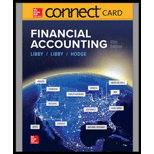
Concept explainers
1.
Classify the given transactions as deferred revenue, deferred expense, accrued expense, and accrued revenue.
1.
Explanation of Solution
Classification:
| Transactions | Type of Adjustment |
| a. | Deferred expense |
| b. | Accrued revenue |
| c. | Deferred expense |
| d. | Accrued expense |
| e. | Deferred expense |
| f. | Deferred expense |
| g. | Accrued revenue |
| h. | Accrued expense |
Table (1)
Description:
Accrued revenue: This is the revenue earned but cash is not received. It is treated as asset until the cash is received. Hence, accrued revenues require adjustment at the end of the year.
Accrued expense: This is the expense incurred but not yet paid. It is treated as liability until the expense is paid. Hence, accrued expenses require adjustment at the end of the year.
Deferred expense: This is the expense paid by a company in advance and would be treated as asset until the cost expires or the benefit is consumed. Hence, prepaid expenses require adjustment at the end of the year.
2.
Journal the adjusting entries for Company C.
2.
Explanation of Solution
Transaction (a):
| Date | Account Titles and Explanation | Post Ref. | Debit ($) | Credit ($) | ||
| December | 31 | Supplies Expense (+E, –SE) | 1,250 | |||
| Supplies (–A) | 1,250 | |||||
| (Record part of supplies consumed) | ||||||
Table (2)
Working note:
Calculate supplies expense.
Transaction (b):
| Date | Account Titles and Explanation | Post Ref. | Debit ($) | Credit ($) | ||
| December | 31 | Accounts Receivable (+A) | 7,440 | |||
| Catering Revenue (+R, +SE) | 7,440 | |||||
| (Record accrued revenue) | ||||||
Table (3)
Transaction (c):
| Date | Account Titles and Explanation | Post Ref. | Debit ($) | Credit ($) | ||
| December | 31 | Insurance Expense (+E, –SE) | 200 | |||
| Prepaid Insurance (–A) | 200 | |||||
| (Record part of prepaid insurance expired) | ||||||
Table (4)
Working Notes:
Calculate insurance expense.
Transaction (d):
| Date | Account Titles and Explanation | Post Ref. | Debit ($) | Credit ($) | ||
| December | 31 | Repairs Expense (+E, –SE) | 600 | |||
| Accounts Payable (+L) | 600 | |||||
| (Record accrued expense) | ||||||
Table (5)
Transaction (e):
| Date | Account Titles and Explanation | Post Ref. | Debit ($) | Credit ($) | ||
| December | 31 | Rent Expense (+E, –SE) | 700 | |||
| Prepaid Rent (–A) | 700 | |||||
| (Record part of prepaid rent expired) | ||||||
Table (6)
Working Notes:
Calculate rent expense.
Transaction (f):
| Date | Account Titles and Explanation | Post Ref. | Debit ($) | Credit ($) | ||
| December | 31 | 2,570 | ||||
| 2,570 | ||||||
| (Record depreciation expense) | ||||||
Table (7)
Transaction (g):
| Date | Account Titles and Explanation | Post Ref. | Debit ($) | Credit ($) | ||
| December | 31 | Interest Receivable (+A) | 4,000 | |||
| Interest Income (+R, +SE) | 4,000 | |||||
| (Record accrued revenue) | ||||||
Table (8)
Working Notes:
Ascertain the amount of interest income adjustment.
Transaction (h):
| Date | Account Titles and Explanation | Post Ref. | Debit ($) | Credit ($) | ||
| December | 31 | Income Tax Expense (+E, –SE) | 6,150 | |||
| Income Tax Payable (+L) | 6,150 | |||||
| (Record accrued expense) | ||||||
Table (9)
Working notes:
Calculate income before taxes.
Calculate income tax expense.
Want to see more full solutions like this?
Chapter 4 Solutions
Connect Access Card For Financial Accounting
- Gaulle Manufacturing had no beginning inventory and adds all materials at the very beginning of its only process. Assume 27,800 units were started, and 12,400 units were completed. The ending work in process is 75% complete. The equivalent units for conversion costs is _?arrow_forwardgeneral accountingarrow_forwardI am searching for the accurate solution to this general accounting problem with the right approach.arrow_forward
- provide correct answerarrow_forwardThe Forging Department of Kahlo Metals Inc. had 1,500 tons in beginning work in process inventory (70% complete) on September 1. During September, 28,400 tons were completed. The ending work in process inventory on September 30 was 2,100 tons (90% complete). What are the total equivalent units for direct materials for September if materials are added at the beginning of the process?arrow_forwardI am trying to find the accurate solution to this financial accounting problem with the correct explanation.arrow_forward

 AccountingAccountingISBN:9781337272094Author:WARREN, Carl S., Reeve, James M., Duchac, Jonathan E.Publisher:Cengage Learning,
AccountingAccountingISBN:9781337272094Author:WARREN, Carl S., Reeve, James M., Duchac, Jonathan E.Publisher:Cengage Learning, Accounting Information SystemsAccountingISBN:9781337619202Author:Hall, James A.Publisher:Cengage Learning,
Accounting Information SystemsAccountingISBN:9781337619202Author:Hall, James A.Publisher:Cengage Learning, Horngren's Cost Accounting: A Managerial Emphasis...AccountingISBN:9780134475585Author:Srikant M. Datar, Madhav V. RajanPublisher:PEARSON
Horngren's Cost Accounting: A Managerial Emphasis...AccountingISBN:9780134475585Author:Srikant M. Datar, Madhav V. RajanPublisher:PEARSON Intermediate AccountingAccountingISBN:9781259722660Author:J. David Spiceland, Mark W. Nelson, Wayne M ThomasPublisher:McGraw-Hill Education
Intermediate AccountingAccountingISBN:9781259722660Author:J. David Spiceland, Mark W. Nelson, Wayne M ThomasPublisher:McGraw-Hill Education Financial and Managerial AccountingAccountingISBN:9781259726705Author:John J Wild, Ken W. Shaw, Barbara Chiappetta Fundamental Accounting PrinciplesPublisher:McGraw-Hill Education
Financial and Managerial AccountingAccountingISBN:9781259726705Author:John J Wild, Ken W. Shaw, Barbara Chiappetta Fundamental Accounting PrinciplesPublisher:McGraw-Hill Education





